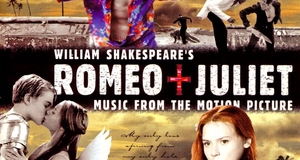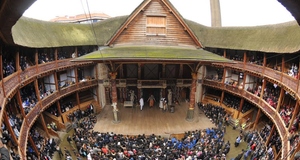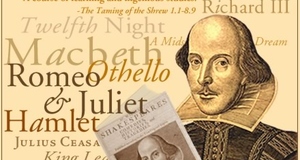James Joyce's "The Dead" Replaying Shakespeare's Romeo and Juliet
By
2010, Vol. 2 No. 11 | pg. 2/2 | « In another example of Shakespearean images borrowed by Joyce, Romeo speaks to his friend Benvolio in the first scene about Rosaline, his alleged love. Losing control of his language, he devalues his transient flame. The three lines “She will not stay the siege of loving terms/ Nor bide th’ encounter of assailing eyes/ Nor ope her lap to saint-seducing gold,” as the footnote elucidates, “contrives to suggest a commercial transaction and an erotic act. It is unlike Romeo to think of buying her favours, and we may suppose his immaturity has allowed the conceit to get out of hand” (Shakespeare 93). Romeo’s commodification of Rosaline and failure to communicate effectively anticipate Gabriel’s opening encounter with Lily in the pantry; both men lose control of their language around these women, forcing them to fall back upon commercial language and “saint-seducing gold.” Joyce perhaps plays out Rosaline’s rejection of Romeo in the pantry scene; at the very least, he again paints a scene mimetic of Romeo and Juliet where eroticism and economics collide. The Morkan party undermines Gabriel so thoroughly that he can be compared perhaps more accurately to Paris, the suitor Juliet loathed so much that she risked poison and feigned death in order to escape a honeymoon with him. Gabriel himself alludes to the marginalized character by recollecting “the headings of his speech: Irish hospitality, sad memories, the Three Graces, Paris, the quotation from Browning” (Joyce 34). While the name “Paris” also alludes to the prince who sparked the Trojan War, it drags the Romeo and Juliet reference in tow. Furthermore, Gabriel’s early debate over whether to include the Browning quotation or substitute a more familiar Shakespearean alternative further suggests the potential in the name “Paris.”Juliet’s nurse describes Paris as “a man of wax,” faultless, though Juliet finds him uninspiring when juxtaposed with her Romeo (Shakespeare 103). Gabriel’s keen hearing (as opposed to his lackluster vision) picks up a dripping sound: “In the silence Gabriel could hear the falling of the molten wax into the tray and the thumping of his own heart against his ribs” (Joyce 53). Thus the images and themes in both works merge; just as Paris presumably realizes that Juliet loves another despite his love for her at the tomb, Joyce writes Gabriel into a parallel scenario centered in the dark hotel room. Gabriel’s most veritable sense, his hearing, connects him by way of wax to the unrequited love of Paris for Juliet, permanently severing him from his Romeo delusions and recasting him in a less flattering mold. Gabriel’s glance towards the mirror confirms this confused reevaluation; “As he passed in the way of the cheval-glass he caught sight of himself in full length, his broad, well-filled shirt-front, the face whose expression always puzzled him when he saw it in a mirror and his glimmering gilt-rimmed eyeglasses” (55). The aggregate of these allusions chain Italy and Ireland together, binding the two countries that serve as Joyce’s temporary residence and homeland, respectively. Both Dublin and Verona find themselves “confined by the protection of (their) walls;” they both “breed a stifling atmosphere with (their) own kinds of fearful menace” that seems fated owing to their rotten cultural superstructures (Shakespeare 61). Although the stark physical contrast between verdant Verona and frosty Dublin—a name that etymologically means “Black Pool”— might suggest bifurcated structural visions, tracing the origins of Romeo and Juliet paves over the incongruity; Brooke and Painter, two previous bards from whom Shakespeare took inspiration to tell the tale of Juliet and her Romeo, both set their stories near Christmas day “so that Romeo’s misery is echoed in the chill and dreary weather, and the light and warmth of the banquet present a rich contrast” (95). The effect on Shakespeare by his predecessors becomes clear in apparent oversights; for instance, the Capulet feast, despite the action’s setting in the middle of July, features a blazing fireplace (115). Joyce reclaims the abandoned effect of winter weather in “The Dead,” juxtaposing the frigid night with the warm Morkan feast, thereby echoing the earlier iterations of Romeo and Juliet. Through its intertextual presence, Romeo and Juliet serves as an enormously important, oft overlooked influence upon Joyce’s final short story; however, the implications of this connection are not necessarily self-evident. Gabriel’s position on the staircase constantly fluctuates; while he casts himself as Romeo when he stares poorly up the stairwell, he gets placed in the opposite position multiple times, first as he looks out the window towards the statue of Wellington and later when he finds himself staring out the hotel window where “he imagined he saw the form of a young man standing under a dripping tree” (59). In both cases, he finds himself in the traditionally feminine position, lorded over by both an imperial presence and the domestic specter of Michael Furey. Here he occupies the same psychological position as Gretta, separated from men of the past by glass and rain. This experience gives Gabriel a greater depth than Romeo, broadening his experience into a feminine sphere to which Romeo never gained psychological access. While Norris may villanize Gabriel, his oscillation between high and low balcony creates a universal character exposed to both father and mother tongue. His connection with Michael Furey becomes as real for Gabriel as Gretta, and Gabriel sees Michael Furey as the symbol of lost love just as vividly as Gretta does. Each cross-textual connection of The Dead reflects Joyce’s own literary ambitions. Joyce calls upon the “King Billy” of Western literature and circles around Shakespeare’s monument as stubbornly as Johnny revolves around William of Orange (Joyce 47). Joyce creates The Dead as a work of sound which summons Furey, the boy called into Gretta’s memory by The Lass of Aughrim and who appears to Gabriel through the blurry window pane before the story’s balcony finale. The final scene is seemingly not told by a Benjy, but instead by a narrator sympathetic to Gabriel and closely aligned with the ambitious young Irish author. Joyce’s foundation is essentially Shakespearean, and captures the paradox of replaying Shakespeare in a different time: while elements remain similar, the work changes upon performance in a new cultural climate. But does “The Dead” sculpt the young Joyce in clear relief? While the underlying structure serves as a tool to channel his artistic image, only Joyce knows whether the verbal echoes clearly resonating on the linguistic level of “The Dead” entered knowingly or unwittingly into the narrative. While this question cannot be definitively answered, the finale of The Dubliners makes it clear that Joyce saw past events as actively participating in the present. The literary world will continue to look back to Joyce and Shakespeare, path dependent on their oft overlapping contributions. ReferencesChang, Vincent J. Shakespeare and Joyce: a Study of Finnegans Wake. University Park and London: The Pennsylvania State UP, 1951. Higdon, David L. "Gendered Discourse and the Structure of Joyce's "the Dead"" ReJoycing : New Readings of Dubliners. Ed. Rosa M. Bolletierri Bosinelli and Harold F. Mosher. Lexington: University P of Kentucky, 1998. Joyce, James. The Dead (Case Studies in Contemporary Criticism). Ed. Daniel R. Schwarz. Boston: Bedford Books of St. Martin’s P, 1994. Levenson, Michael. "Living History in ‘The Dead’" The Dead (Case Studies in Contemporary Criticism). Ed. Daniel R. Schwarz. Boston: Bedford Books of St. Martin’s P, 1994. 163-178. Norris, Margot. "The Politics of Gender and Art in ‘The Dead’" Suspicious Readings of Joyce's Dubliners. Philadelphia: University of Pennsylvania P, 2003. 216-236. Rabinowitz, Peter J. “‘A Symbol of Something’: Interpretive Vertigo in ‘The Dead’" The Dead (Case Studies in Contemporary Criticism). Ed. Daniel R. Schwarz. Boston: Bedford Books of St. Martin’s P, 1994. 137-147. Shakespeare, William. Romeo and Juliet. Ed. Brian Gibbons. 2nd ed. London: Arden, 2002. Endnotes1.) Rabinowitz sets himself against Stanley Fish’s “concern with the temporal process of reading as it is taking place” and posits “hypothetical, rather than concrete, flesh-and-blood readers” (Rabinowitz 138). 2.) For an example of a dubious leap, Rabinowitz points to one critic that claimed William Holman Hunt’s painting Awakening Conscience colors Gabriel’s vision in the balcony scene even though “the key elements in Joyce’s scene, the staircase and the angle of vision, are not even present in The Awakening Conscience” (Rabinowitz 143). 3.) There are strong cases for the importance of a variety of allusions. Most notably, Margot Norris develops her chapter “The Politics of Gender and Art in ‘The Dead’” using both Romeo and Juliet and Ibsen’s The Doll’s House; yet privileging Shakespeare makes sense because, as Samuel Goldberg argues, “when we look for real artistic affinities rather than influences or symbolic techniques, I think the closest analogue is not Dante, or Mallarme, or Blake, or Flaubert, or even Ibsen, but Shakespeare…” (Goldberg 219-20). 4.) For instance, although Norris agrees that Gabriel forces himself upon Lily, she does not explain why an abused woman would serve Gabriel, “three potatoes which she had reserved for him” (Joyce 39, emphasis mine). Suggested Reading from Inquiries Journal
Inquiries Journal provides undergraduate and graduate students around the world a platform for the wide dissemination of academic work over a range of core disciplines. Representing the work of students from hundreds of institutions around the globe, Inquiries Journal's large database of academic articles is completely free. Learn more | Blog | Submit Latest in Literature |


















